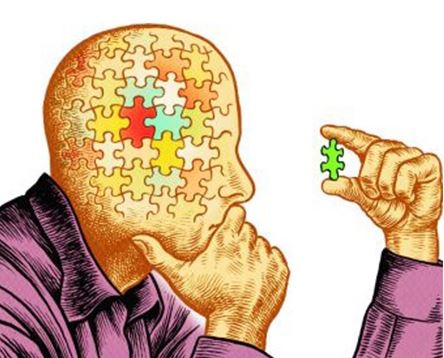I Do Not Feel Like It
Feelings, Resistance And How To Take Action
How to acknowledge your feelings without being ruled by them

We all know that voice: “I do not feel like it.”
It shows up when you need to start the report, make the call, exercise, meditate, or have the difficult conversation. You’ve decided what you want to do — yet a quiet resistance says no. The impulse to delay, distract, or avoid feels stronger than your intention.
The truth is, not feeling like it is one of the most common and least examined blocks to clear, purposeful action.
It’s rarely laziness or lack of discipline. It’s usually something deeper - an emotional or cognitive pattern designed to keep you safe and comfortable.
The challenge is how to find the right balance:
- On one hand, feelings are real and need to be acknowledged.
- On the other, we can’t afford to let them dictate our actions.
This article explores that tension - between feeling and doing - and how to act with clarity even when you do not feel like it.
The Reality of “I Do Not Feel Like It”
Most of us assume motivation precedes action: that we must first feel like doing something before we can do it. But in reality, it often works the other way around. Action generates motivation; movement generates energy.
The phrase “I do not feel like it” is simply a statement of our current emotional state. It’s information, not a command. Yet we often interpret it as a reason - or worse, an instruction - to stop.
From a Zen Tools perspective, the first step is to recognise that this feeling is just one more mental event arising in awareness. It doesn’t define you, and it doesn’t need to control you.
As we explored in "You Are Not Your Thoughts" the thought “I do not feel like it” triggers a matching emotional tone - heaviness, resistance, lethargy, anxiety.
These feelings then feed back into more thoughts [“I’ll do it later”, “I’m too tired”, “What’s the point?”], creating a self-reinforcing loop.
Breaking the loop begins by seeing it - noticing what’s happening without judging yourself.
Feelings as Data Not Directives
Our feelings are part of our internal guidance system.
They carry useful data - but only if we can interpret them clearly.
“I do not feel like it” might mean:
- I’m physically tired.
- I’m anxious about failing.
- I’m avoiding discomfort.
- I’m overwhelmed and need to simplify.
- I’m disconnected from why this matters.
Each of those is valid information. But none of them automatically justify inaction.
Here five questions you can use to move from emotional reaction to practical clarity:
- What is actually happening right now?
- What is my body telling me about this?
- What story am I telling myself?
- Can I live with this feeling for now?
- What’s the next small step I can take?
These questions shift your focus from emotion to observation - from being inside the feeling to seeing it as a transient signal.
That shift in perspective gives you room to choose.
Hidden Resistance to Change

Even when we know what we want and why it matters, we can still feel blocked.
We all carry unconscious “immunity systems” - hidden commitments that protect us from perceived risks. You might consciously commit to “being more productive,” but unconsciously be committed to “avoiding failure” or “staying safe.”
When those two commitments collide, the emotional system wins.
The hidden commitment creates a feeling that justifies inaction. “I don’t feel like it” becomes a protective signal — a subtle form of self-preservation.
The immunity system isn’t your enemy; it’s an outdated safety mechanism. It once kept you safe from criticism, rejection, or uncertainty. But now it keeps you stuck. A practical reflection:
When you notice the “I don’t feel like it” reaction, ask yourself:
- If I did this, what discomfort am I trying to avoid?
- What am I unconsciously committed to protecting?
- Is that protection still serving me?
By identifying the hidden commitment behind the feeling, you transform resistance into awareness. And once it’s conscious, you regain choice.
Acting Without Feeling Like It
Once you’ve acknowledged the feeling, seen the story, and recognised any hidden commitments, what then?
You act anyway.
This is not about forcing yourself or denying your emotional life. It’s about aligning action with clarity rather than mood.
In Zen Tools language: awareness first, acceptance second, action third.
- Awareness – Notice the thought-feeling pattern [“I don’t feel like it”].
- Acceptance – Allow the feeling to exist without fighting or obeying it.
- Action – Choose the next step that aligns with your values or intentions.
Sometimes that next step is very small - opening the document, putting on your shoes, making the first call.
But that tiny act breaks the inertia.
Once you start, momentum grows.
Remember: feelings follow action more often than action follows feelings.
When It's A Signal To Rest
Of course, sometimes the feeling is valid information.
It can be a signal that you’re depleted or misaligned.
If the resistance is chronic, check the context:
- Are you trying to do too much?
- Is the task aligned with what truly matters?
- Are you confusing busyness with purpose?
Disconnection from meaning can create emotional dullness. If you’ve lost the sense of why, you’ll naturally stop feeling like it.
In that case, the answer isn’t to push harder, it’s to reconnect.
Step back, rest, and revisit your purpose.
Once meaning returns, motivation follows.
Integrating Feeling and Action
The goal is not to suppress feelings or to be ruled by them, but to integrate them intelligently.
When you practice thought-awareness, you create a small but powerful gap between feeling and doing.
Within that gap lies freedom - the freedom to choose your response.
Here’s a simple framework you can use anytime you catch yourself saying “I don’t feel like it”:
- Notice – Pause and acknowledge the feeling without judgment.
- Name – Identify what’s really going on (fear, fatigue, overwhelm, boredom).
- Neutralise – Drop the story; see the feeling as passing data.
- Navigate – Choose your next step based on values, not moods.
Over time, this becomes a habit - a calm, clear way of engaging with life.
You stop fighting your feelings and stop obeying them. You learn to work with them.
The Quiet Power of Consistency
You build confidence not by waiting to feel ready, but by doing what matters even when you don’t. Each time you act through resistance, you send yourself a new message:
“I can feel discomfort and still move forward.”
That’s the essence of mental resilience - not the absence of emotion, but the ability to act with awareness in its presence.
In practice, that might mean:
- Writing the first sentence instead of waiting for inspiration.
- Going for a short walk instead of skipping exercise entirely.
- Making one phone call instead of planning the perfect outreach strategy.
Small, consistent actions compound. They rebuild trust in your own capacity to act - regardless of mood.
Over time, the phrase “I do not feel like it” loses its power.
A Final Thought
You don’t need to fight your feelings. You just need to stop letting them run the show.
Acknowledge them. Understand them. Use them as data. Then act with clarity anyway.
That’s what practical Zen looks like in everyday life — the quiet, grounded ability to see what is true, and to move forward with awareness, even when you don’t feel like it.
Key Takeaways:
Further Reading:
Rewiring Your Autopilot – How To Harness Your Subconscious Mind
The Battle For Your Mind - How To Win Inner Freedom In A Digital Age
Why You Need To Be Intimate With Your Own Thinking
Universal Awareness and the Machinery of Thought
How To Activate And Engage With The Wise Advocate
Return from: "I Do Not Feel Like It " to: Managing Personal Change or Inner Mastery For Outer Impact
Next Article: Master The Season You Are In - The Key to Fulfilling Your Purpose
LATEST ARTICLES
The Battle For Your Mind - How To Win Inner Freedom In A Digital Age Of Distraction
 From External Events to Inner Events. We often think of “events” as things that happen out there: the traffic jam, the rude comment, the delayed email reply. But what truly shapes our experience is wh…
From External Events to Inner Events. We often think of “events” as things that happen out there: the traffic jam, the rude comment, the delayed email reply. But what truly shapes our experience is wh…How to See Your Thoughts Without Becoming the Story
 A Practical Guide to Thought-Awareness. You can spend your life inside the stories of your mind without ever learning how to see your thoughts clearly and objectively. Most of the stuff we tell oursel…
A Practical Guide to Thought-Awareness. You can spend your life inside the stories of your mind without ever learning how to see your thoughts clearly and objectively. Most of the stuff we tell oursel…The Collison Decision Matrix - A Simple Framework for Better Choices
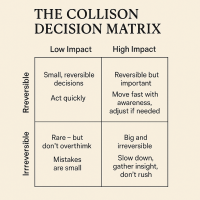 The Collison Decision Matrix Is A Practical Everyday Thinking Tool. Most of us spend a surprising amount of time worrying about decisions. From small ones such as what to wear, what to eat, what to te…
The Collison Decision Matrix Is A Practical Everyday Thinking Tool. Most of us spend a surprising amount of time worrying about decisions. From small ones such as what to wear, what to eat, what to te…The Power Of Asking The Right Question
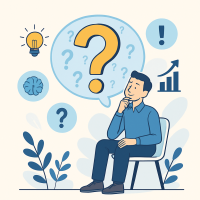 The Power Of Asking The Right Question Lies In The Quest For Insight. To experience the power of asking the right question you must develop the practice of asking questions. The best way to improve th…
The Power Of Asking The Right Question Lies In The Quest For Insight. To experience the power of asking the right question you must develop the practice of asking questions. The best way to improve th…Site Pathways
 Here is a site pathway to help new readers of Zen-Tools navigate the material on this site. Each pathway is based around one of the many key themes covered on this site and contain a 150 word introduc…
Here is a site pathway to help new readers of Zen-Tools navigate the material on this site. Each pathway is based around one of the many key themes covered on this site and contain a 150 word introduc…How To Live With Contradiction - Beyond Thought Let Stillness Speak
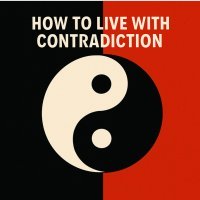 A major impact on so many peoples' lives is the situational contradiction of unfilled realistic expectations. So where does all this leave us? Well here we are, with mental equipment that is more lim…
A major impact on so many peoples' lives is the situational contradiction of unfilled realistic expectations. So where does all this leave us? Well here we are, with mental equipment that is more lim…How To Trust The Process Of Mindfulness - Right Now
 In mindfulness, the process isn’t some distant goal — it's what is happening right now. When we talk about how to trust the process of mindfulness the credibility of the process is heavily dependent…
In mindfulness, the process isn’t some distant goal — it's what is happening right now. When we talk about how to trust the process of mindfulness the credibility of the process is heavily dependent…Inner Mastery For Outer Impact - Mental Clarity For Effective Action
 Insights only matter if they translate into consistent action. In a world crowded with quick fixes and motivational soundbites, the theme “Inner Mastery for Outer Impact” calls us to something more e…
Insights only matter if they translate into consistent action. In a world crowded with quick fixes and motivational soundbites, the theme “Inner Mastery for Outer Impact” calls us to something more e…The Wise Advocate - Helping You Achieve The Very Best Outcome
 The focus of your attention in critical moments of choice either builds or restricts your capacity for achieving the best outcome. When we talk of 'The Wise Advocate' its easy to think of the consigl…
The focus of your attention in critical moments of choice either builds or restricts your capacity for achieving the best outcome. When we talk of 'The Wise Advocate' its easy to think of the consigl…Trust The Process - Beyond The Cliche
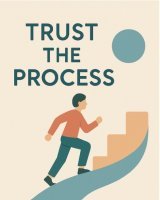 The phrase "trust the process" has become a cliche, the woo-woo mantra of the "self help" industry. Those three little words feel like they ought to mean something useful but hidden behind them are a…
The phrase "trust the process" has become a cliche, the woo-woo mantra of the "self help" industry. Those three little words feel like they ought to mean something useful but hidden behind them are a…The Dopamine Delusion - Why Anticipation Beats Achievement
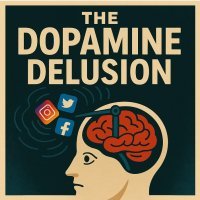 The thrill we feel is not in the having, but in the wanting. The more we have, the more we want. The more things we acquire and the easier things get for us, the more discontent we feel. The more spo…
The thrill we feel is not in the having, but in the wanting. The more we have, the more we want. The more things we acquire and the easier things get for us, the more discontent we feel. The more spo…The Power Of Silence Is Experienced In Your Use Of Language
 Practise the "Beneficial Neurological Delay" for optimal comprehension. The power of silence is experienced in your use of language, specifically: - How you formulate the words you use to think and in…
Practise the "Beneficial Neurological Delay" for optimal comprehension. The power of silence is experienced in your use of language, specifically: - How you formulate the words you use to think and in…

